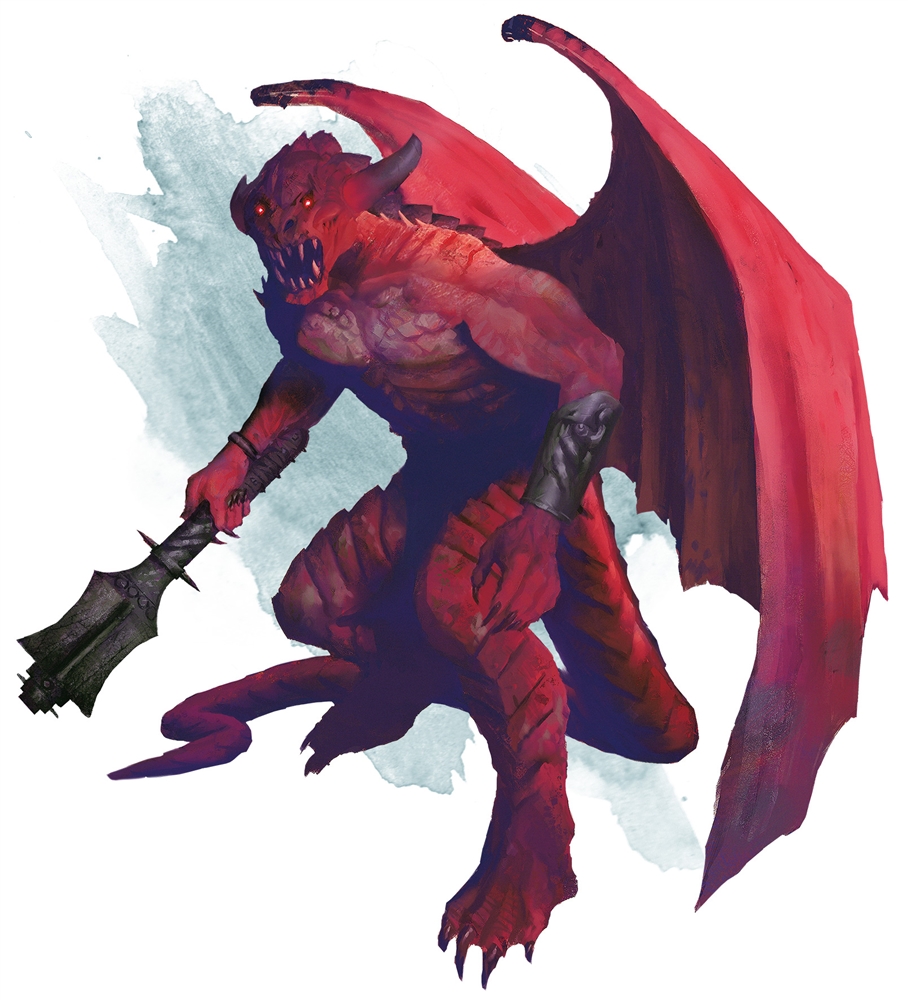With a snap of your fingers, the looming silhouette of the BBEG shrinks down, down until instead of the deadliest warrior in the known multiverse, all you’re faced with is a single, very surprised looking chicken. The rogue bars the doors to the throne room and starts a sand timer.
“One hour to go, everyone,” he says, grimly cocking a pair of hand crossbows. “Then we end this thing once and for all.”
“Not a problem,” the sorcerer mutters, fingers deftly tracing the necessary arcane sigils to cast Leomund’s Tiny Hut. “We’ve got all the time we need. One hour from now, the true polymorph transformation will be complete, and we can put an end to this guy’s dastardly plans once and for all — the old-fashioned way.”
“What’s the old-fashioned way?” asks the wizard, trying desperately to avoid being pecked by the world’s most genocidally inclined hen.
“Simple,” grins the rogue, bending down to look the chicken directly in its two beady little eyes. “We take it to the lowest level of the Abyss and give it to the first demon lord we find as a snack.” Then, into the stunned silence, he adds: “Oh, and then we run like hell, of course.”

This is the third universe-threatening foe the party has done this to, and their excursions to the depths of the abyss are starting to feel less like death-defying conclusions and more like dropping off a pizza. Last time they were down there, Graz’zt tipped them for heaven’s sake.
That’s right, folks. Today, we’re going to be talking about one of the most versatile, powerful, dare I say absolutely-pants-on-head-bonkers-broken-nonsense spells in all of Dungeons & Dragons 5e. It’s the reason anyone becomes a transmutation wizard in the first place: it’s True Polymorph.
Have you ever wanted to turn a god into a hamster and keep it as a pet? How about turning a dragon into a pair of woolen socks? How about turning yourself into a dragon? FOREVER!? Congratulations, you’ve beaten the dungeon, and now you’re the dragon. You win D&D, I guess.

Today, we’re going to break down exactly how the spell True Polymorph works, its limitations and who can cast it as well as share a few tips for getting the most out of this spell at the table, which should hopefully make a decent case for why your ultra high-level wizard, warlock, or bard should consider grabbing True Polymorph over some of the other truly monumental options available to you at this level.
True Polymorph
- Level: 9th level
- Casting Time: 1 Action
- Range: 30 ft.
- Duration: 1 Hour (Concentration)
- School: Transmutation
- Class: Bard, Warlock, Wizard
- Effect: Buff/Shapechanging
- Attack/Save: Wisdom Save
- Components: Verbal, Somatic, Material (a drop of mercury, a dollop of gum arabic, and a wisp of smoke)
Spell Description: When you cast this spell, choose a single creature or nonmagical object within range that you can see. You can choose to transform a creature into a different creature, a creature into a nonmagical object, or an object into a creature as long as the object is neither being worn nor carried by another creature.
The spell lasts for the duration or until the target drops to 0 hit points or dies. If you concentrate on this spell for the full duration, the spell lasts until it is dispelled.
Shapechangers or creatures with 0 hit points cannot be affected by the spell, and an unwilling creature targeted by the spell can make a Wisdom saving throw to prevent itself from being affected.
Based on the target of the spell and its new form chosen by the caster, there are three permutations of True Polymorph, each of which behaves differently.
Creature into Creature. If you turn a creature into another kind of creature, the creature’s new form can be any kind you choose whose challenge rating is equal to or less than the target’s (or its level if the target doesn’t have a challenge rating). The target’s game statistics, including mental ability scores, are replaced by the statistics of the new form. It retains its alignment and personality.
The target assumes the hit points of its new form, and when it reverts to its normal form, the creature returns to the number of hit points it had before it transformed. If it reverts as a result of dropping to 0 hit points, any excess damage carries over to its normal form. As long as the excess damage doesn’t reduce the creature’s normal form to 0 hit points, it isn’t knocked unconscious.
The creature is limited in the actions it can perform by the nature of its new form, and it can’t speak, cast spells, or take any other action that requires hands or speech unless its new form is capable of such actions.
The target’s gear also melds into the new form. The creature can’t activate, use, wield, or otherwise benefit from any of its equipment. However, its equipment also cannot be removed from its person while the creature is transformed.
Object into Creature. You can turn an object into any kind of creature as long as the creature’s size is no larger than the object’s size and the creature has a challenge rating of 9 or lower. The newly transmuted creature is friendly to you and your companions, acting on each of your turns under your control. The GM has the creature’s statistics and resolves all of its actions and movement. If the spell becomes permanent, you no longer control the creature. It might remain friendly to you, depending on how you have treated it.
Creature into Object. If you turn a creature into an object, it transforms along with whatever it is wearing and carrying into that form as long as the object’s size is no larger than the creature’s size. The creature’s statistics become those of the object, and the creature has no memory of time spent in this form after the spell ends and it returns to its normal form.
Who Can Cast True Polymorph?
True Polymorph is a 9th-level spell available only to the dedicated arcane spellcasting classes — bards, warlocks (via their Mystic Arcanum feature), and wizards. Even at 20th level, no character is able to cast this spell more than once per long rest.
How Do I Use True Polymorph?
I read somewhere that when you start getting into 9th-level spell territory, casting is less of an excisement of the mystic and magical arts and more of an argument with a god over who gets to keep your prized pet schnauzer in the divorce. Things can get ugly. Lawyers may be involved.
One of the things that makes True Polymorph (along with the other truly reality-shattering 9th-level spells like Wish and Imprisonment) so powerful is how vague and open-ended it is. Any form for a creature? Turn any creature into any nonmagical object? Effectively bring the chair you’re sitting in to life?
(Incidentally, this is one of my favorite things to do in any game I run: give an NPC the backstory that they used to be a chair who was awakened by a powerful wizard using a True Polymorph spell. Then, if that NPC dies, I like to sit back and watch the PCs lose their minds as, with their dying breath, their long-term friend and ally breathes his last breath and transforms back into a tastefully crafted mid-century sofa. Bonus points if their name was Chesterfield and you kept engineering situations where the PCs ended up sitting on top of him.)
Stupid, long-running gag NPCs aside, the possibilities for using True Polymorph are virtually endless, but all more or less fall into two categories depending on whether you’re targeting yourself (or an ally) or an unwilling creature.
If You’re the Target…
Then True Polymorph can transform any character into their own boss monster, giving them the form (and abilities) of any creature with a CR equal to or lower than their level. Considering you get this spell when you’re level 17, let’s just look at some of the forms you can imitate between 17th and 20th levels.
- Androsphinx (CR 17): A powerful spellcaster with legendary actions that can teleport every round and emit an increasingly potent roar that eventually paralyzes enemies, knocks them prone, and adds insult to injury with a truckload of thunder damage.
- Adult Gold Dragon (CR 17): Yo, dawg. We heard you like polymorph, so we polymorphed you into a creature that can polymorph, so you can polymorph while you’re true polymorphed. Also, you can breathe fire and are a dragon.
- Sibriex (CR 18): A huge, pustulent, plague-marred pile of demonic flesh and malevolence that can warp the flesh of its enemies at will. Useful if you need to, say, convince a whole enemy army that the world is ending.
- Ancient Crystal Dragon (CR 19): Sure, it’s one of the lowest-CR ancient dragons, but it’s still a freaking ancient dragon. If you want a really good one though, you’ll have to wait for level 20 when you can play as an…
- Ancient Topaz/White/Brass Dragon (CR 20): Finally, something to sink your giant, razor-sharp teeth into. A host of legendary actions, a breath weapon that can level cities, fear effects, spellcasting, more polymorphing — whatever you want — congratulations; now you’re the boss monster.
- Pit Fiend (CR 20): However, my personal favorite choice is the at-will fireball-slinging, 300-hp-having, four god damn multiattack-making vice president of hell itself. Seriously, the BBEG should probably just go home at this point.

Whatever form you choose, you’re signing up for a bucketload of extra hit points, a ton of free abilities (and probably some legendary actions) that you can fire off with impunity, magic resistances, damage immunities — everything that the enemies you’re fighting are also bringing to the table. Set this up ahead of time, and you don’t even have to worry about breaking concentration.
However, sometimes it’s impractical to spend long stretches of time in a different shape, and maybe even transforming into a freaking pit fiend won’t be enough to wipe that smug smile off the archvillain’s face. So, you have to go down the other route when using True Polymorph and wipe away the villain’s face altogether.
If You’re Not the Target…
Using true polymorph to permanently turn one of the multiverse’s most dangerous monsters into a hatstand is not only funny, but it’s also highly practical. Assuming you can take the full hour necessary to complete the transformation, congratulations. The BBEG is now almost completely neutralized.
Whatever you do, however, don’t let their new body come to any harm.
What Are the Limitations of True Polymorph?
Even 9th-level spells have their drawbacks and their prices to pay. In the case of True Polymorph, it’s that, if the form the target is polymorphed into ever hits 0 hp (even if the spell has become “permanent”), the target reverts to its original form with all of the hit points it had when it was alive.
Therefore, turning the BBEG into a mouse and stepping on that mouse will just mean that you return the BBEG to their original form (albeit maybe with 1-2 fewer hp), so True Polymorph’s applications as an offensive spell are, on the face of it, limited.
Turning the target into a creature is also a little fraught as a long-term disable effect because they may be able to take steps to kill their weakened animal form or just die of the animal’s old age (turning a Balor into a mayfly only buys you a day), so it’s probably best you stick to objects as a form of eternal prison for the nastier liches in your life.
(As an aside, I think this might be one of the most fun ways that I, as a DM, use to have the PCs release ancient evils trapped inside mundane artifacts. You’re more or less recreating that Japanese game show where one thing in the room is chocolate [except instead of chocolate, the doorknob is Vecna — and, boy, is he mad], and it could end up being a fun type of Russian Roulette or a hilarious Jackie Chan-esque fight scene as your PCs try to prevent potentially cursed jar after potentially cursed jar from being smashed by cultists.)

Obviously, it’s unfortunate that a target of True Polymorph reverts back to its original form when it reaches 0 hit points, but that doesn’t mean you can’t get creative with the spell or even use it to insta-kill the BBEG; you just need to add a few extra steps.
True Polymorph and Tiny Hut (Plus Some Other Neat Little Tricks)
Need a little more time to turn the BBEG into a small lump of unidentifiable rock forever?
Don’t bother fighting off wave after wave of henchmen for a whole hour. Cast Leomund’s Tiny Hut, thus creating an impenetrable eight-hour barrier that your enemies cannot penetrate. Turn the BBEG into a small metal pill, swallow him, and smuggle him out of his fortress.
Speaking of which…
Need to get absolutely anywhere unnoticed by detect magic spells, detect good and evil, or even truesight?
Turn yourself into a small rock, metal pill, or glass marble. You’re instantly innocuous and travel sized. Bonus points if you can be crushed at a dramatic moment in order for a big reveal. Obviously, you have no control over your actions while you are in inanimate form and no memory of your time in that state, so make sure you use the buddy system.
Need to polymorph a magic item?
Well, too bad. Polymorph only works on nonmagical objects… and any creature who happens to be carrying a magical item. If all your gear (magical or otherwise) is schlorped into your new form when you’re true polymorphed, then surely the best way to hide away a powerful cursed item is to hire the nearest level 0 peasant to hold it for, like, two seconds, polymorph them into an inconspicuous rock, and then hide that rock in the bottom of a mine somewhere. Is it ethical? Probably not. Did I just solve Lord of the Rings? You tell me… Hold still, Frodo…
Frequently Asked Questions
What Can I True Polymorph Into?
You can true polymorph into any creature or nonmagical object, as long as its CR is equal to or lower than your character level.
Is True Polymorph Permanent?
It can be. Once the spell’s 1-hour duration is up, the polymorph effect lasts until it is dismissed or dispelled or the polymorphed creature drops to 0 hp or dies. As long as these things don’t happen, the spell theoretically lasts forever.
Does an Antimagic Field Affect True Polymorph?
Because an antimagic field suppresses magical effects rather than ends them, an antimagic field (like a beholder’s main eye ray, for example) should temporarily return a true polymorphed creature or object to its original form. However, as soon as the field is no longer covering the polymorphed creature or object, it reverts to the form chosen for it by the spellcaster.
Can I True Polymorph Into a Tarrasque?
No. Because player characters’ levels are capped at 20 and the Tarrasque’s CR is 30, the True Polymorph requirement for the caster’s level to be equal or greater than their chosen form’s CR is not fulfilled. If there were a CR 30 spellcaster (unlikely, as even the archlich Vecna’s CR taps out at 26), they could conceivably True Polymorph themselves into a tarrasque.
- About Author
- Latest Posts
I played my first tabletop RPG (Pathfinder 1e, specifically) in college. I rocked up late to the first session with an unread rulebook and a human bard called Nick Jugger. It was a rocky start but I had a blast and now, the better part of a decade later, I play, write, and write about tabletop RPGs (mostly 5e, but also PBtA, Forged in the Dark and OSR) games for a living, which is wild.
